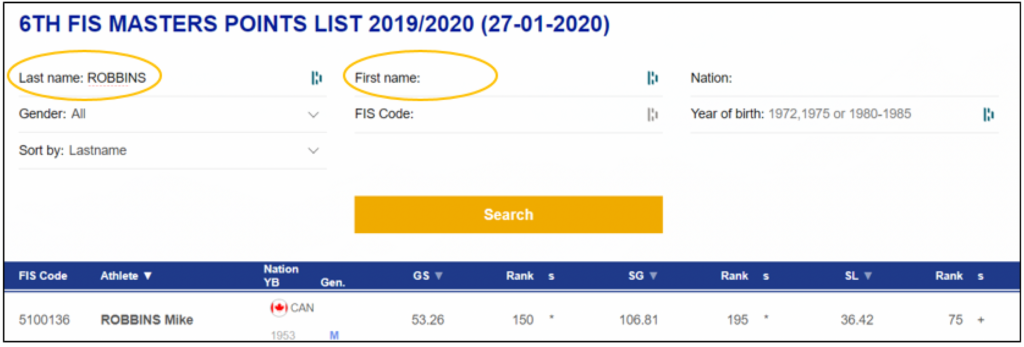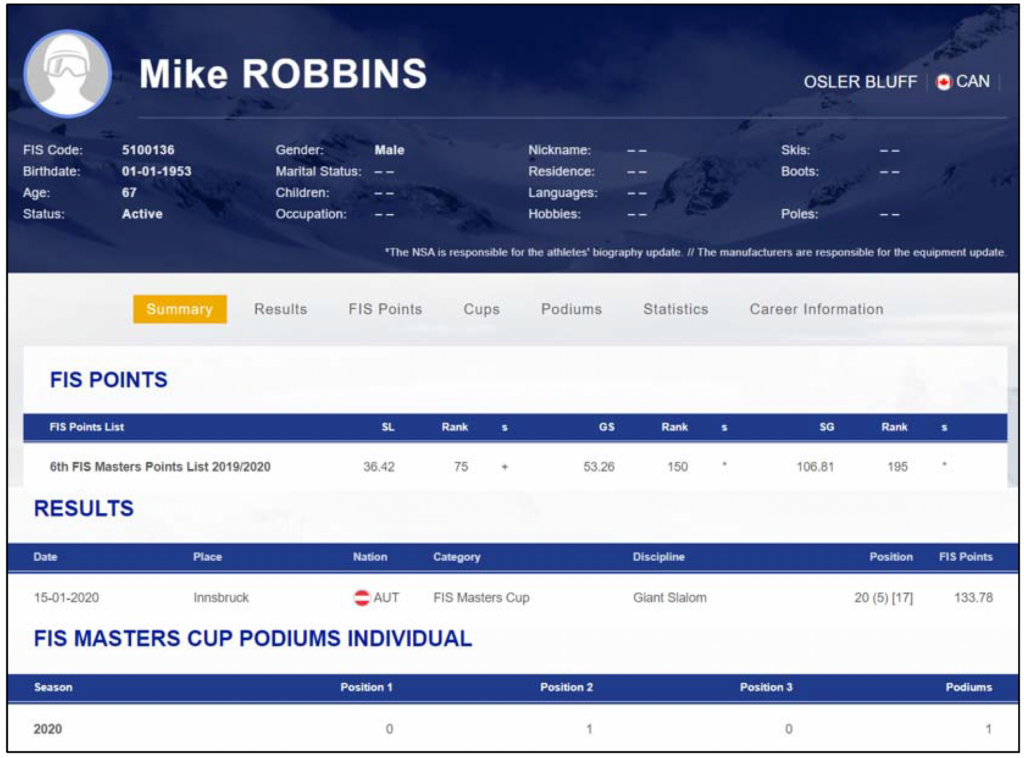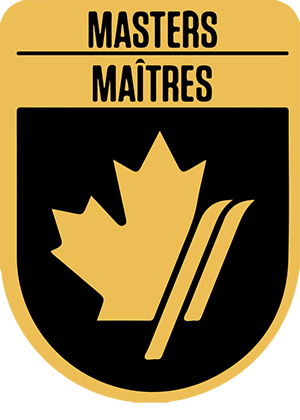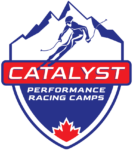FIS 101 for Masters
Submitted by Mike Robbins, Canadian Alpine Masters’ FIS Subcommittee & Member of Osler Bluff Ski Club Canada is back on the international calendar for Masters’ FIS racing with the FIS Masters’ Cup (FMC) coming to Stoneham, Quebec, from 20‐23 February 2020. If you are planning to attend, or thinking about attending the Stoneham FMC races, then this article is intended to provide you with a general introduction to Masters’ FIS racing, in Canada and internationally. Each year the Masters’ FIS race calendar includes races in the southern hemisphere in September, and then in the northern hemisphere (Europe, North America and Japan) from November through April. The FMC is equivalent to the FIS World Cup for Juniors, and Masters are able to pursue both Crystal Globes and World Criterium (similar to World Championships) as well as individual race medals and trophies.
Why chose to race on the Masters’ FIS circuit:
- International camaraderie.
- Consistent high quality of races set to FIS standards.
- Great value races and skiing in incredible ski resorts.
- Opportunity to race and ski in some of the iconic ski racing destinations globally.
- Courses and venues are generally Masters friendly.
- Highest levels of Masters’ competition globally.
- To obtain a global ranking and see how you fare amongst Masters worldwide.
- To pursue a Crystal Globe: Crystal Globes (same style of globe as on the World Cup but smaller) are awarded to the top three in each age class (best 12 races) and the best in each category and discipline. This is the penultimate prize for any Master’s trophy case. It’s fun and like being a kid again.
The races:
- In Masters’ FIS racing there are three categories broken into 5 year age classes:
- Category A men has 6 age classes (A1 – A6) for ages 30 – 59 years.
- Category B men has 7 age classes (B7 – B13) for ages 60 to 90+.
- Category C women with 13 age classes (C1 – C13) for ages 30 – 90+; in large field races this category will sometimes be divided into category C and D, similar to the two men’s categories.
- Masters’ FIS races are held on FIS homologated (certified) trails in the same way that Junior FIS races are only held on homologated trails.
- Over the 2019/2020 season there are 58 FMC races with the season beginning in September in South America.
- Typically, there are an additional 10 Masters’ (MAS) races in countries just getting into Masters’ FIS racing e.g. Japan and Australia. The MAS races do not count towards a Crystal Globe and they have a set race penalty of 30 FIS points per Category, compared to the FMC races with 0 penalties.
- Every year there is a World Criterium (World Championships) held in different locations that includes a super G, a giant slalom and a slalom, plus an extra FMC giant slalom; typically the highest attendance events on the calendar, next to the WWMG.
- This year, for the first time, FIS sanctioned the Winter World Masters’ Games (WWMG) so that the WWMG races count as FMC races.
- Masters’ FIS races typically award medals for the top 3 in every age class and trophies for the best time of the day in each category A, B and C/D.
- Normally categories C (women) and B (men over 60) race together and on a separate slalom course to the category A (men under 60). Separate courses are also preferred in GS races, but not mandated.
- Masters competing in FMC races collect World Cup points for results by age class (5 year increments) and by categories A, B and C/D. First place collects 100 points declining down to 1 point for 30th position.
- The norm in Europe is to have 1‐run GS races, however, there are exceptions where 2‐run GS races are staged. In slalom and giant slalom, the ‘Bibo’ rule is used for second runs whereby the top five positions are reversed and the remaining racers start in order of first run finish. This year FIS has begun to include some alpine combined races with 1‐run each of super G and slalom.
Equipment requirements:
- The only hard and fast equipment requirement is for super G where men under 65 years must have a minimum of 185 cm skis and women under age 55 years require a minimum of 180 cm skis.
- All other equipment rules published by FIS are simply recommendations. It is typical to see many Masters’ FIS racers use 25‐27 metre radius GS skis and 33 metre radius super G skis.
What you need to know to see your standings as a FIS Master:
- Have a basic understanding of Masters’ FIS points as different to Junior FIS points. The main difference is there is no calculated penalty for each race as on the Junior circuit. FMC race results start at 0 for the winners in each category. Lower FIS points can be important in the larger races to ensure a good start bib.
- Know how to navigate the Masters’ FIS pages on the FIS website. (Note: Navigation can vary depending on browsers and devices e.g. Chrome on a Windows pc was used for screen shots and instructions below.)
- All information about Masters’ racing can be found on the FIS website under More Disciplines:

- Click on FIS Points and then click on the most current FIS Points List as Masters’ FIS points are updated at regular intervals through the year.

- Type your last name and first name (if you have a common last name) in the appropriate fields and enter or click on Search. Your best two Master’s FIS points in each season, by discipline, are averaged to arrive at your points at the beginning of the next season.

- Click on your name under the Athlete column to take you to your individual FIS profile that includes your current and past Master’s FIS race results and your FIS points profile, by discipline. Alternatively, go to the Athletes page, enter your last name and first name (as above) and enter or click on Search. You can click on each race result to be taken to your full class results for that race.

- As of this 2019/2020 season, North America has 8 or 9 FMC races, with one series in the US and one in Canada.
- In 2023, Canada has the chance to host the World Criterium that only comes to North America every 5 years.
What if you want to pursue a Crystal Globe:
- Crystal Globes are awarded for 1st, 2nd and 3rd in each age class counting the best 12 races, and for the overall and discipline winners by Categories A, B and C. The overall category Globe is based on a maximum of the best 7 slalom results, the best 7 giant slalom results and the best 4 super G results. The overall category discipline Globes are based on a maximum of 4 results for super G and 7 each for slalom and giant slalom.
- To pursue a Globe in your age class (1st, 2nd or 3rd) you will need to collect 11 or 12 good results through the regular season in advance of the finals, which in the most competitive classes will likely mean a good number of podiums. From the Masters’ home page, click on the Cup Standings page to check your standings in your age class and category by using the filters alongside each field; class standing is the most important one for most racers but you can also view overall category standings.

- The finals that take place in early April, count for double world cup points so if you are serious about a Globe you will need to attend the finals; with double points, final places can change.
- With 6 FMC races in South America and as many as 9 in North America, racers could conceivably only go to Europe for the finals and still win an age class Globe.
References:
- Good article on Masters’ Globe pursuit, from a few years ago, in Ski Racing magazine at the time when there were only 4 FMC races in South America and 4 in North America.
- Masters’ FIS calendar for the 2019/20 season.
- Masters’ rules for techies who may be interested in the rules for racers, organizers, course-setters and more.









